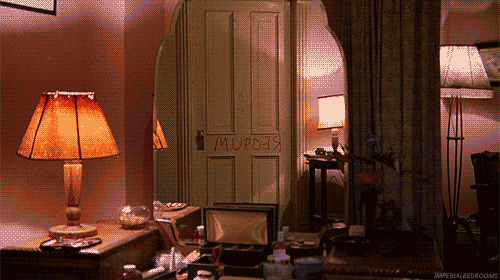So I started with Kubrick's The Shining. Not only had I never seen it before, but this was my first time watching any movie by Stanley Kubrick. Putting aside all of the myths and reputation that surrounds the guy (I mean, 127 takes for one scene? Come on man.) I gotta say that I was really impressed. I haven't been that drawn in and held by a 2.5 hour film - or any film, for that matter - in a pretty long time. I've read the book, and even though it differs significantly/Stephen King hated the adaptation/Nicholson is just a littleeeee too over the top, it really worked as a standalone product. It was also the kind of horror movie that I can get behind; creepy, but never made me feel like I was going to piss my pants.
Kubrick pulls out pretty much every horror movie trick in the book, but uses them all in ways that never feel trite or cliched. I'll go over just a couple of them, and try my best to explain why they're so effective.
1. The Jump Scare
Ah, the old go-to, and the real reason why I hate a vast majority of horror movies. Kubrick uses these sparingly in Shining, but when he does, he uses them to great effect. Typically, the jump scare will be the payoff after a bit of increasingly brutal tension-building, partnered with a loud, punctuated sound effect. It works, but 80% of the time it just comes off as a cheap, annoying scare. The only time Kubrick uses these are when you least expect it. There's no build up, for example, the first time that he cuts to the blood pouring out of the elevator doors - that entire montage comes out of nowhere and is terrifying. Same goes for when Jack kills Halloran towards the end of the movie. It's entirely unexpected, and all the better for it.
2. The Reveal
3. Sometimes the scariest thing is never shown on screen
Pretty self-explanatory, I think. More often than not, your imagination is capable of scaring you way worse than any image actually could. This is what makes scenes like when Danny first shows up with a bruised neck so powerful. We know that he goes into room 237 and we know that HE SHOULDN'T FUCKING GO INTO ROOM 237, but for the moment, the lack of any visible antagonist is worse than anything they could have shown in the room at the time. We know it's not Jack or Wendy, so...we imagine the worst. The same thing goes for any horror movie. I've never seen It Follows or Rosemary's Baby, but apparently in both, the lack of something makes it all the more scary. Sometimes, the best way to create this sense of dread is by showing your entire environment in a wide shot, and let the audience's imagination work overtime, trying to predict where and when something will pop out. The indefinite waiting is usually worse than than the actual monster.
Also, last but not least, those whip zooms? Seriously digging it.



No comments:
Post a Comment